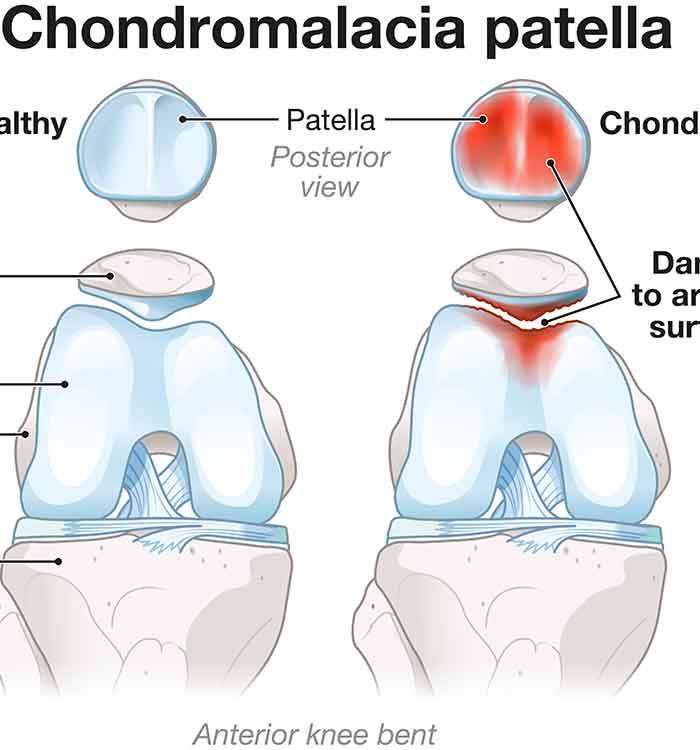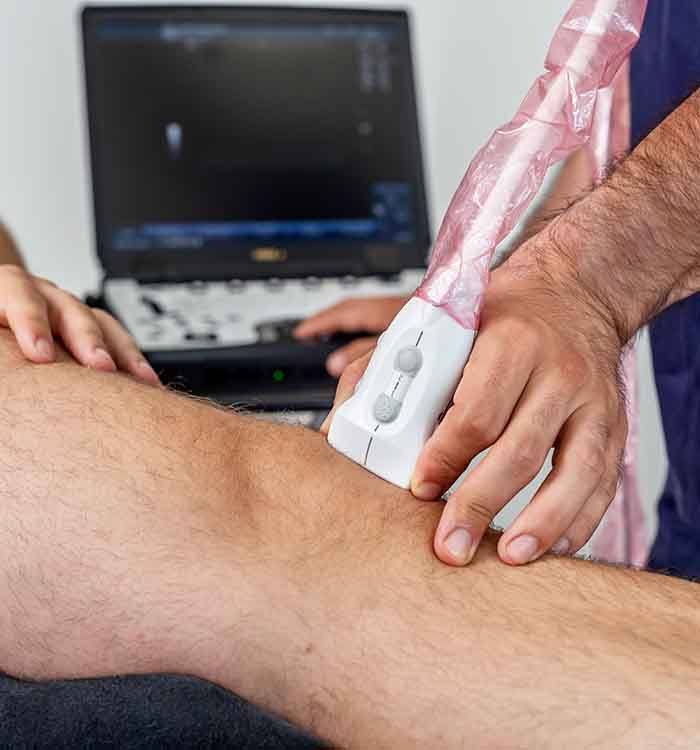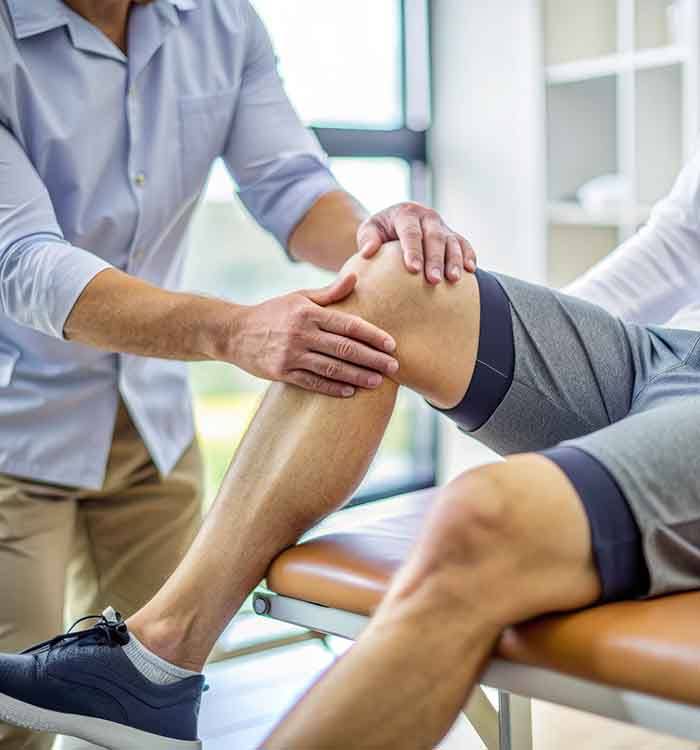
Chondromalacia Patellae Treatment Asheville
Find Relief from Runner’s Knee
Knee pain can make it difficult to walk, sit, stand, or climb stairs. It can have drastic consequences for your quality of life! Fortunately, effective treatments are available to address various causes of knee pain, including a condition known as chondromalacia patellae (a type of runner’s knee). If you believe you have this problem, continue reading below to learn more about it and potential treatment options from our Asheville Non-Surgical Orthopedics team.
What Is Chondromalacia Patellae?

Chondromalacia patellae is one of the most common causes of knee pain among patients in the United States. In fact, it may affect up to 20% of people in the country, and it is the leading cause of anterior knee pain among young athletes.
Your patellae, also known as your kneecaps, should normally glide smoothly over your knee joint. A layer of cartilage should make this movement painless. Unfortunately, that cartilage can soften or even deteriorate, leading to chondromalacia patellae.
Contrary to what its common name implies, chondromalacia patellae as a form of runner’s knee is not always caused by running (in fact, running is not inherently bad for your knees). A range of factors can contribute to its development, including:
- Poor joint alignment
- Weak quadriceps or hamstrings (these are the muscles in the fronts and backs of your thighs)
- An imbalance between the muscles on the insides and outsides of your thighs
- Direct trauma to your kneecaps
- Repeated stress to your knees, from running or other activities
- Arthritis
- Flat feet
- Overweight and obesity
The Symptoms of Chondromalacia Patellae

The most common symptom of chondromalacia patellae is pain in the knee region. It may affect one or both knees. Depending on its severity, other symptoms might include:
- A grinding or grating sensation in your knees
- Swelling
- Knee instability
- Stiffness
- Bone-on-bone pain
The above-listed symptoms may be caused by various conditions, so it is important to get an accurate diagnosis.
How Is Chondromalacia Patellae Diagnosed?

In order to diagnose chondromalacia patellae, our team will need to examine your knees. We will also ask about your symptoms. Details such as when they started, their severity, and the exact nature of your discomfort can provide us with valuable insight that helps us arrive at a diagnosis.
We may also use imaging equipment, such as musculoskeletal ultrasound, to capture images of the cartilage under your kneecaps.
How We Treat Chondromalacia Patellae

The best treatment for chondromalacia patellae depends on the details of each case. At-home measures, such as rest, may lead to minor improvements. Of course, a professional assessment is still important. Often, we recommend that patients with this condition attend physical therapy sessions. Targeted exercises can strengthen the muscles that affect your knees, which can lead to a reduction in symptoms. Exercises that are non-weight bearing, such as swimming or riding a stationary bike, may be particularly beneficial.
In more severe cases, surgery may be necessary to correct misalignment and promote proper movement of the knee joints.
In our office, we offer a number of treatments that can help to address runner’s knee, including:
- Shockwave Therapy (ESWT): This uses acoustic waves to improve blood flow, reduce inflammation, and stimulate tissue repair.
- MLS Laser Therapy: This is a dual-wavelength laser system that reduces pain and inflammation while promoting cellular regeneration.
- Osteopathic Manipulative Therapy (OMT): This addresses alignment and mobility issues that contribute to improper knee mechanics.
- PRP Injections: This regenerative medicine injection uses your body’s own blood platelets to deliver growth factors to the knee and promote cartilage repair.
- Prolotherapy & Prolozone: These treatments help to strengthen ligaments and reduce instability by triggering a localized healing response.
- Stem Cell Therapy: Stem cells are regenerative cells that help to repair damaged cartilage. It is often used in moderate cases that do not respond to more conservative treatment methods.
Chondromalacia Patellae FAQs
Is There Any Way to Prevent Chondromalacia Patellae?
You may be able to reduce your risk of chondromalacia patellae by doing the following:
- Properly warm up and stretch before exercising, especially if you will be doing strenuous or high-intensity activities like running or jumping.
- Strengthen your leg muscles and glutes. A good strength training routine can support muscle health and help to stabilize your knees.
- Avoid overuse of your knees. Get enough rest between periods of intense physical activity.
- Invest in a good pair of shoes. Supportive, well-fitting shoes can support the health of your entire musculoskeletal system, including your knees.
- Maintain a healthy weight to reduce stress on your knees.
Is There a Difference Between Chondromalacia Patellae and Runner’s Knee?
Runner’s knee is a general term that can apply to different conditions that affect the knee joints, including chondromalacia patellae. It can also be used to refer to other problems, such as structural issues with the kneecaps, tight muscles, and more. If any doctor diagnoses you with “runner’s knee,” it would be wise to ask for additional details so you understand the nature of your situation.
How Long Will I Need to Attend Physical Therapy to Treat Chondromalacia Patellae?
Many patients need to attend physical therapy for 4 – 6 weeks to experience significant improvements in their chondromalacia patellae. However, it is important to remember that each patient is unique; some need more or fewer therapy sessions.
Following the completion of your professional physical therapy sessions, you should continue to practice prescribed exercises that can strengthen your legs and knees.
Who Is Most at Risk for Chondromalacia Patellae?
Almost anyone can develop chondromalacia patellae. However, certain groups are at a higher risk than others. For example, this condition affects women more frequently than men, possibly due to slight anatomical differences between the sexes. Older people, athletes in general, and obese individuals are also at an increased risk.
Is Chondromalacia Patellae Reversible?
Returning the cartilage to its original state is not generally possible, even with an excellent treatment plan. However, with the proper care, your symptoms may be greatly reduced or even completely eliminated.
That is why early intervention is so important. Instead of suffering with knee pain and simply hoping that it will go away, you should seek care at the first sign of a problem. Prompt treatment may prevent chondromalacia patellae from worsening and increase the chances that conservative care will be effective. If you wait too long, you could be faced with significant knee pain and even the possibility of surgery.